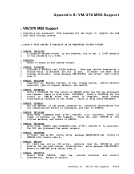its DASD address is then determined and passed back to the calling
routine. IfDKKPGT cannot find a cylinder with a de-allocated slot, it
enters the cylinder allocation phase. When an available cylinder is
found, it constructs a page allocation block for this cylinder and
allocates a page to the caller.D!KPGT controls the paging and spooling I/O load of the systea by allocating cylinders evenly across all available channels and devices.
In order for a device to be considered available for the allocation of
paging and spooling space:• Its volume serial number must appear in the system's owned list. • It must have at least one cylinder of temporary space aarked as
available in the cylinder allocation block which is located on
cylinder0, head 0, record 3. I • It must not be an KSS 3330V volume. At system initialization time, CPINIT reads in the allocation records
for eachvolume and constructs the chains of device allocation blocks from which D!KPGT allocates the cylinders. In managing the cylinder
allocation,D!KPGT takes three factors into consideration: device type,
device address, and possible status as a preferred paging device.A request for a cylinder of virtual storage page space is satisfied by allocating space on a preferred paging device, provided that one
exists on thesystem and that it has page space available. Preferred paging devices are specified by the installation at systea generation time, and generally should be devices on which excessive seek times do
not occur.A typical preferred paging device would be the IBM 2305 Pixed Head Storage facility. If the 2305 is assigned as a preferred
device, it is possible to allocatesome of its space for other
high-priority data files without excessively degrading paging. Anexample of such usage would be for high activity read-only saved systea pages that are not shared in real storage, and high-activity systea residence disks.
It is also possible to designate movable-headDASD devices such as
the3330, 3340, 3350 and 2314/2319 Direct Access storage facilities as
preferred paging devices. The module(s) so designated should not be
required to seek outside of a relatively narrow cylinder band around the
center of the paging areas. It is advisable to share the accessara of
a movable-head preferred paging device with only the lowest-usage data
files.
If one ormore preferred devices are defined on the systea, CP allocates all of the page space available space on these before it
allocates on any other available owned volumes. Within the class of
preferred devices, space is allocated first on the fastest devices, and
these are spread out across channels and devices. Allocation on
nonpreferred devices is spread out in thesame aanner. cylinders for
spooling space are not allocated from preferred devices. Allocation on
a given device is donefrom the relative center of the volume outward, a
cylinder at a time in a zig-Zag fashion in anattempt to miniaize seek
tiaes.
1-112IBM V!/370 System Logic and Problem Deteraination--Voluae 1
routine. If
enters the cylinder allocation phase. When an available cylinder is
found, it constructs a page allocation block for this cylinder and
allocates a page to the caller.
In order for a device to be considered available for the allocation of
paging and spooling space:
available in the cylinder allocation block which is located on
cylinder
for each
allocation,
device address, and possible status as a preferred paging device.
exists on the
not occur.
device, it is possible to allocate
high-priority data files without excessively degrading paging. An
It is also possible to designate movable-head
the
preferred paging devices. The module(s) so designated should not be
required to seek outside of a relatively narrow cylinder band around the
center of the paging areas. It is advisable to share the access
a movable-head preferred paging device with only the lowest-usage data
files.
If one or
allocates on any other available owned volumes. Within the class of
preferred devices, space is allocated first on the fastest devices, and
these are spread out across channels and devices. Allocation on
nonpreferred devices is spread out in the
spooling space are not allocated from preferred devices. Allocation on
a given device is done
cylinder at a time in a zig-Zag fashion in an
tiaes.
1-112








































































































































































































































































































































































































































































